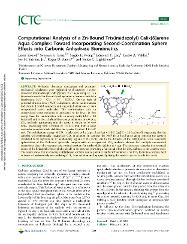| dc.contributor.author | Koziol, Lucas | |
| dc.contributor.author | Eşsiz, Şebnem | |
| dc.contributor.author | Wong, Sergio E. | |
| dc.contributor.author | Lau, Edmond Y. | |
| dc.contributor.author | Valdez, Carlos A. | |
| dc.contributor.author | Satcher, Joe H. Jr. | |
| dc.contributor.author | Aines, Roger D. | |
| dc.contributor.author | Lightstone, Felice C. | |
| dc.date.accessioned | 2019-06-27T08:03:40Z | |
| dc.date.available | 2019-06-27T08:03:40Z | |
| dc.date.issued | 2013 | |
| dc.identifier.issn | 1549-9618 | en_US |
| dc.identifier.uri | https://hdl.handle.net/20.500.12469/825 | |
| dc.description.abstract | Molecular dynamics simulations and quantum-mechanical calculations were performed to characterize a supra-molecular tris(imidazolyl) calix[6]arene Zn2+ aqua complex as a biomimetic model for the catalyzed hydration of carbon dioxide to bicarbonate H2O + CO2 -> H+ + HCO3-. On the basis of potential-of-mean-force (PMF) calculations stable conformations had distorted 3-fold symmetry and supported either one or zero encapsulated water molecules. The conformation with an encapsulated water molecule is calculated to be lower in free energy than the conformation with an empty cavity (Delta G = 1.2 kcal/mol) and is the calculated free-energy minimum in solution. CO2 molecule partitioning into the cavity is shown to be very facile proceeding with a barrier of 1.6 kcal/mol from a weak encounter complex which stabilizes the species by about 1.0 kcal/mol. The stabilization energy of CO2 is calculated to be larger than that of H2O (Delta Delta G = 1.4 kcal/mol) suggesting that the complex will preferentially encapsulate CO2 in solution. In contrast the PMF for a bicarbonate anion entering the cavity is calculated to be repulsive in all nonbonding regions of the cavity due to the diameter of the calix[6]arene walls. Geometry optimization of the Zn-bound hydroxide complex with an encapsulated CO2 molecule showed that multiple noncovalent interactions direct the reactants into optimal position for nucleophilic addition to occur. The calixarene complex is a structural mimic of the hydrophilic/hydrophobic divide in the enzyme providing a functional effect for CO2 addition in the catalytic cycle. The results show that Zn-binding calix[6]arene scaffolds can be potential synthetic biomimetics for CO2 hydration catalysis both in terms of preferentially encapsulating CO2 from solution and by spatially fixing the reactive species inside the cavity. | en_US] |
| dc.language.iso | eng | en_US |
| dc.publisher | Amer Chemical Soc | en_US |
| dc.rights | info:eu-repo/semantics/openAccess | en_US |
| dc.subject | N/A | en_US |
| dc.title | Computational Analysis of a Zn-Bound Tris(imidazolyl) Calix[6]arene Aqua Complex: Toward Incorporating Second-Coordination Sphere Effects into Carbonic Anhydrase Biomimetics | en_US |
| dc.type | article | en_US |
| dc.identifier.startpage | 1320 | en_US |
| dc.identifier.endpage | 1327 | |
| dc.relation.journal | Journal Of Chemical Theory And Computation | en_US |
| dc.identifier.issue | 3 | |
| dc.identifier.volume | 9 | en_US |
| dc.department | Fakülteler, Mühendislik ve Doğa Bilimleri Fakültesi, Biyoinformatik ve Genetik Bölümü | en_US |
| dc.identifier.wos | WOS:000316168700003 | en_US |
| dc.identifier.doi | 10.1021/ct3008793 | en_US |
| dc.identifier.scopus | 2-s2.0-84874880879 | en_US |
| dc.institutionauthor | Eşsiz, Şebnem | en_US |
| dc.relation.publicationcategory | Makale - Uluslararası Hakemli Dergi - Kurum Öğretim Elemanı | en_US |
| dc.identifier.pmid | 26587594 | en_US |
















